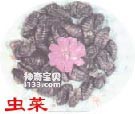Someone has noticed the edible nature and cultural significance of insects a long time ago. There are many contents about insect food recorded in our country's classical books. There are early records of people eating bumblebees or carpenter bees (larvae or pupae) in Erya in the early Han Dynasty. "Book of Rites" contains records of emperors and nobles using cicadas and bees as delicacies at banquets before the Qin and Han Dynasties. "Lingbiao Luyi" written by Liu Xun in 877 AD records: The chiefs in the caves of Jiaoguang River collected ant eggs from the masses, pickled them with salt and made a sauce called antzi sauce, which was used to entertain official guests, relatives and friends. The book "Compendium of Materia Medica" written by Li Shizhen in the Ming Dynasty recorded a total of 76 species of edible and medicinal insects. "In the first year of Zhenguan in the Tang Dynasty, there were locusts in the summer. People steamed locusts to explode, removed their wings and ate them. This is recorded in "The Complete Book of Agricultural Affairs" written by Xu Guangqi. "Wu Shu" records that "Yuan Shu was in Shouchun, and the people were hungry, so he used mulberry sticks and locusts as dry food." It records that locusts were used as food.

The use of insects as food and dishes has a long history in our country, and some are even listed as imperial meals. Since ancient times, people of all ethnic groups in my country have had the custom of eating different types of insects as food. There are about hundreds of species of insects used as food in various parts of China, including bean hornworm larvae and pupae, sweet potato hornworm, sesame hornworm, grape hornworm, peach hornworm, Elaeagnus elata looper, pine caterpillar, damselfish moth, thorn moth Moths, camphor silkworms, tea silkworms, silkworms, tussah silkworms, pink bollworms, corn borers, bamboo borers, locusts, dragon lice, cicadas, wasps and bees are all nutritious foods and are widely eaten by people everywhere.
The Jinuo people of Yunnan like to eat ants and feces beetles. People in Xiangxi, Hunan, like to eat fried and roasted honeycomb. In freshwater waters such as ponds in Guangdong and Guangxi, aquatic insects such as dragon lice and field turtles are abundant and easy to collect. Local people process dragon lice and field turtles into precious foods. They think that dragon lice taste like ham and field turtles taste like ripe pears and banana. Jiangsu and Zhejiang are the most developed areas for raising silkworms in my country, and silkworm pupae are extremely abundant. In addition to leaving a small amount for seeding, local people also steamed, pickled and stir-fried a large number of silkworm pupae, or made silkworm pupae sauce for consumption. In Tianjin and Beijing, people have the habit of eating fried locusts; they are called "fried grasshoppers" (Note: Locally, locusts are called grasshoppers). In ancient times, people in locust areas who were often harmed by locusts used the captured locusts as food. They were pickled, dried or fried and sold in the market, called "locust rice" and "drought rice". Shrimp". After rural children catch locusts, they bury them in the cooking stove and use the ashes after turning off the fire to roast them for a while and then pull them out. They are charred on the outside and tender on the inside, crispy and delicious. In some areas of Jiangxi, there is also the custom of eating roasted cicadas, fried tea weevil larvae, and raw oil-coated wasps.
Have you ever heard of using insect feces to make "tea" for guests to drink? This is a custom in Sichuan and Guizhou. Hunan Tongdao, Chengbu and other places also like to drink insect tea. They harvested the excrement of pests that harmed the tea trees, dried it in the sun, and then preserved it, giving it the name "insect tea". What these pests feed on are tea leaves. They only absorb certain nutrients they need through their digestive systems, and the feces they excrete still retain some components of the tea leaves. It is said that this "worm tea" is a precious drink for entertaining guests and is sold to Hong Kong. There are also those that use washed and disinfected fly larvae or artificially cultured fly larvae as food. Wash the fly maggots, dry them, grind them into powder, add auxiliary materials, and mix the flour to make a tribute cake, which is called "Bazhen cake". Or use meat to raise maggots to make the maggots enlarged. After washing, add seasoning oil and stir-fry them for consumption. This is commonly known as "fried granulation". People in the Wuyishan area of Fujian Province fry bee pupae and add salt and pepper to entertain rare guests.
Nowadays, insect food series are coming out one after another, and tussah pupae are selling well in the northern non-staple food market. The "Fried Jinchan Canned Food" factory has been built in Shandong. "Mountain Ant Bone Strengthening Liquid", "Ant Wine", "Silkworm Wine", "Three-leaf Insect Tea", "Ant", "Termite" and other products appear in the food market . Insect food and entomophagy have unknowingly penetrated into human food culture and life.
animal tags:
We created this article in conjunction with AI technology, then made sure it was fact-checked and edited by a Animals Top editor.